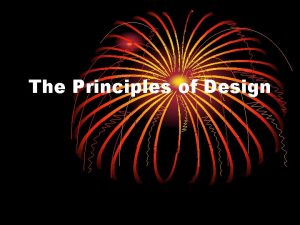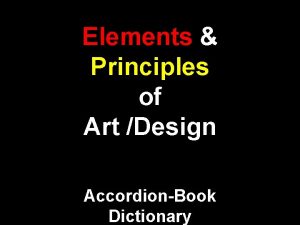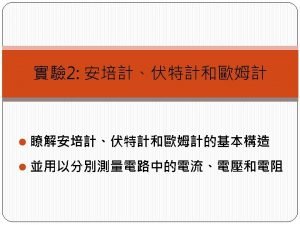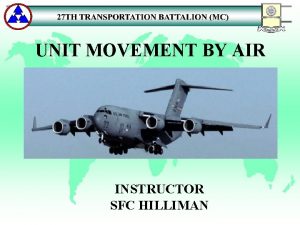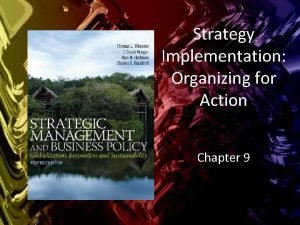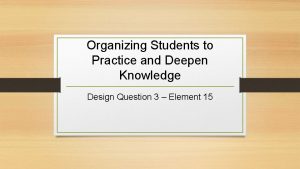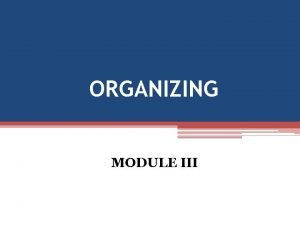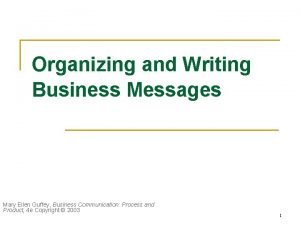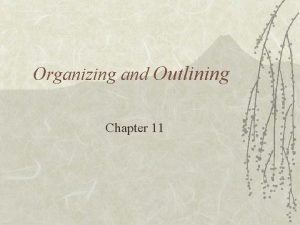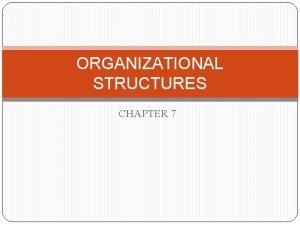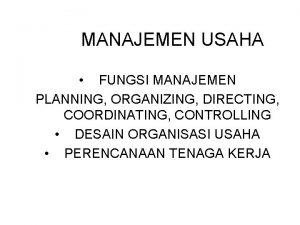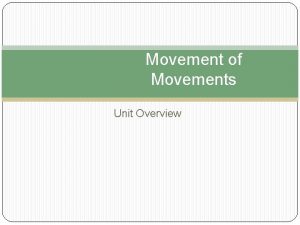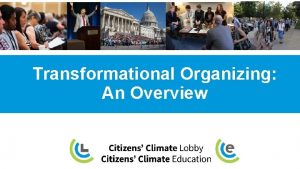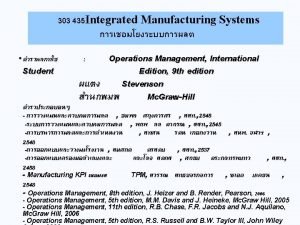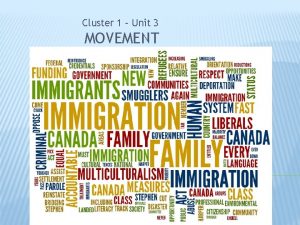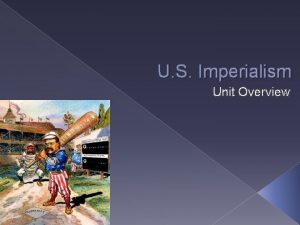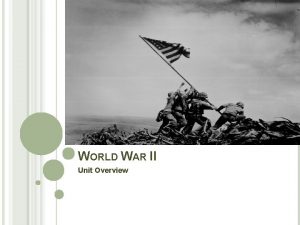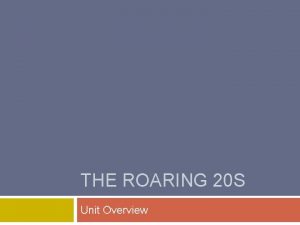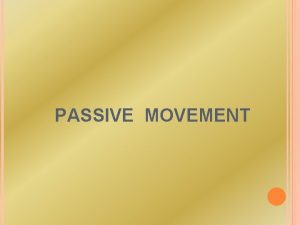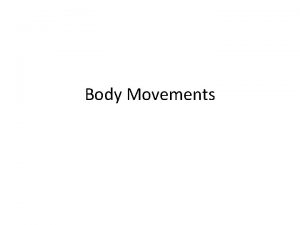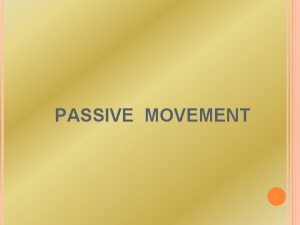A Movement of Movements Unit Overview Organizing Principle



















- Slides: 19

A Movement of Movements Unit Overview

Organizing Principle The experience of World War II began to challenge conventional wisdom regarding race relations in the United States. Following the global conflict, African-Americans created a national conflict by challenging the racial hierarchy that ran directly against the basic principles that this country was founded on. Black Americans, followed by other minority groups that were excluded from the American dream, fundamentally changed the American narrative by standing up for their rights during the 1950 s through the 1970 s.

Black Status Quo �South under Plessy v. Ferguson � 1950— 15 million African Americans 2/3 live in the South �Jim Crow South De facto segregation—by law Disfranchisement �North �Secure access to some public accommodations �Tokenism Jackie Robinson—integrated baseball (1947) �Global politics �America defined? Exposes the disparity in American Credo �Decolonization

The Seeds of Revolt � WWII �Military service �Labor activism—A. Phillip Randolph �Protests during the war � Congress of Racial Equality (CORE) Sit-ins Second Great Migration � The American Dilemma (1944) � Gunnar Myrdal � Truman Era �“To Secure These Rights”—gov’t. commission �Desegregates the military (1948) � NAACP �Legal attack Smith v. Allwright (1944) � White primary declared unconstitutional Sweatt v. Painter (1950) � Equality in Law Schools � Baton Rouge, LA �Bus boycott 1953

Brown V. Board of Education �Courts take lead �Chief Justice Earl Warren � Brown v. Board of Education of Topeka, Kansas (1954) o Desegregates public schools • “all deliberate speed” o Cracks Plessy v. Ferguson legal precedent � Brown II o Local solutions �Southern reaction—resistance �Move to impeach Warren �Southern Manifesto— 1956 � 99 politicians to resist Brown �White Citizens’ Council �Shift to “private” schools �Stalls integration � Deep South— 2% of blacks integrated in 10 years


Awareness �Emmett Till � 14 year old Chicagoan �Spends summer in Mississippi �Does not adhere to racial etiquette �Whistles at a white women �Brutally murdered by vigilantes �Murderers acquitted by an all white jury �National media picks up the story

Mobilization in Montgomery �Rosa Parks �Seamstress �NAACP Secretary �Refuses to give up her seat 12/1/1955 �Arrested �Calls for a boycott (12/55 -01/56) �Montgomery Improvement Association �E. D. Nixon—labor leader � Organized through the church �Martin Luther King Jr. � Spokesman for boycott �White community/businesses resist �Supreme Court �Rules segregation of buses unconstitutional in AL

Civil Rights in 1957 � Central High School �Little Rock, Arkansas(1957) � School integration � “Little Rock Nine” � Governor Orval Faubus � Sends in national guard � Violates court order to prevent integration � Ike sends in troops to protect black students � Faubus challenged federal authority � Civil Rights Act of 1957 � Establishes permanent government commission o Investigates violations of civil rights � “Protects” voting rights � Southern Christian Leadership Conference (1957) � Political agency of black churches who supported Civil Rights � MLK—face of the movement

Direct Action Phase �“Sit-in” movement begins � 01 February 1960 � Greensboro, NC �Movement spreads across the South �“Ghandian” Non-Violence � Student Non-Violent Coordinating Committee (SNCC)— 1960 �Ella Baker

Kennedy and Civil Rights �Election of 1960 �Kennedy calls Coretta Scott King �Black voters �Kennedy moves slowly �“With a stroke of a pen” �Discrimination in housing � Does not follow through �Wary about Dr. King’s associates �Communist ties �Voter Education Project �Funding encouraged by the Kennedy’s

Freedom Rides �Freedom Riders (1961) �CORE tests supreme court ruling on interstate busing �Desegregate bus stations �Met with violence � Alabama—KKK and local law enforcement � Federal Marshals dispatched

Stand Off at “Ole Miss” �University of Mississippi �September 1962 �James Meredith granted admission by SCOTUS �Gov. Ross Barnett blocks Meredith �Kennedy calls in Federal Marshals �October 1962 �Protect Meredith �Mob congregates in protest �Violence ensues �Kennedy calls in MS National Guard �Two dead, 160 marshals injured

The Student Movement �Students for a Democratic Society (SDS) �Al Haber and Tom Hayden �“Port Huron Statement” � Participatory democracy � Anti-imperialism �The Free Speech Movement (FSM) �University of California—Berkeley �Political participation on campus �The “New” Left �White, middle-class and from the North �Assisted in protest movements �Civil Rights and Anti-War Movement

Birmingham Campaign �Antecedents �Albany, GA �SCLC & Project C � April 1963—attempt to end segregation �Stated sit-downs and marches �Encourage student involvement �Police get violent �Eugene “Bull” Connor � Fire hoses, dogs and nightsticks used on students �Kennedy sends in mediators �Klan launches bombing campaign � 16 th Street Baptist Church �Media Frenzy! �Letter from a Birmingham Jail

U. S. Government and Civil Rights �Congress �The 23 rd Amendment (1960) � Electoral votes for D. C. �The 24 th Amendment (1962) � Abolished poll tax � Implemented in 1964 �Supreme Court �Baker v. Carr (1962) � Equalized representation of voters in TN �JFK (1963) �Civil Rights Commission �Proposes Civil Rights Act �Resistance still ripe �Medgar Evers assassinated in MS

March on Washington (for Jobs and Freedom) � 28 August 1963 �Planned by A. Philip Randolph �Economic concern � Unemployment � Income inequality � Living standards �Hope to rally congress to pass Kennedy’s Bill �“I Have a Dream” �Critics �Malcolm X

Gender Equality �Social Feminism �Labor and radicals �Equal Rights Feminism �Middle class �The Feminine Mystique �Betty Freidan (1963) �“The problem that has no name” �Kennedy �Equal Economic Opportunity Commission (EEOC) �Workplace discrimination

The Death of JFK � 22 November 1963 �Open aired motorcade �Downtown Dallas, TX �JFK shot �Lee Harvey Oswald arrested �Jack Ruby? �US mourning �Warren Commission �Conspiracy? �LBJ sworn in—takes up civil rights
 Define axial movement
Define axial movement How did mendeleev organize his periodic table
How did mendeleev organize his periodic table Movement and non movement area
Movement and non movement area Informal email to a friend
Informal email to a friend Unit 6 review questions
Unit 6 review questions Principle of design that indicates movement
Principle of design that indicates movement A two dimensional decorative visual repetition
A two dimensional decorative visual repetition D arsonval meter
D arsonval meter Unit movement plan example
Unit movement plan example Introduction of portfolio
Introduction of portfolio Planning organizing staffing directing controlling
Planning organizing staffing directing controlling Organizing committee structure for an event
Organizing committee structure for an event Strategy implementation organizing for action
Strategy implementation organizing for action Directing coordinating staffing
Directing coordinating staffing Organizing students to practice and deepen knowledge
Organizing students to practice and deepen knowledge Work specialization
Work specialization Example of paragraph
Example of paragraph Organizing an outline
Organizing an outline Lattice organizational structure
Lattice organizational structure Fungsi manajemen coordinating
Fungsi manajemen coordinating





